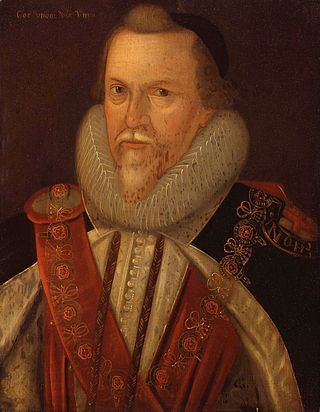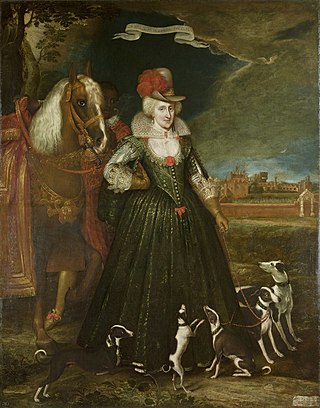Related Research Articles

Thomas Cecil, 1st Earl of Exeter, KG, known as Lord Burghley from 1598 to 1605, was an English politician, courtier and soldier.

Theophilus Howard, 2nd Earl of Suffolk, was an English nobleman and politician.

Haynes is a village and civil parish in Bedfordshire, England, about seven miles (11 km) south of Bedford. It includes the small hamlet of Haynes Church End. It used to be known as Hawnes. North from Haynes is a hamlet named Silver End, then further up is Herrings Green, Cotton End and Shortstown. There is a pub, "The Greyhound", a shop, a post office, a village hall and a Lower School.

Sir John Fortescue of Salden Manor, near Mursley, Buckinghamshire, was the seventh Chancellor of the Exchequer of England, serving from 1589 until 1603.

John Harington, 1st Baron Harington of Exton in Rutland, was an English courtier and politician.

Alice Spencer, Countess of Derby was an English noblewoman from the Spencer family and noted patron of the arts. Poet Edmund Spenser represented her as "Amaryllis" in his eclogue Colin Clouts Come Home Againe (1595) and dedicated his poem The Teares of the Muses (1591) to her.

Thomas Erskine, 1st Earl of Kellie was a Scottish peer.
Sir William Herrick or Hericke was an English jeweller, courtier, diplomat and politician who sat in the House of Commons at various times between 1601 and 1622.
Sir Francis Palmes was an English politician.
John Murray, 1st Earl of Annandale was a Scottish courtier and Member of Parliament.
Sir Edward Zouch of Woking was a courtier to English kings James and Charles I, a masque actor, and Knight Marshal of the King's Household.
Mary Middlemore was a Courtier and Maid of Honour to Anne of Denmark, subject of poems, and treasure hunter.
Elizabeth Roper was a member of the household of Anne of Denmark. She married Robert Mansell, a glass-making entrepreneur and became involved in his business. She was noted for her business activities as a "capitalist" by the historian Alice Clark.
Mary Gargrave was a courtier to Anne of Denmark.
Elizabeth Harcourt, Courtier to Anne of Denmark.
George Rotheram (1541-1599) was a Member of Parliament for Bedfordshire.

Sir Thomas Griffin was an English landowner and hosted the royal family at Dingley.
Philadelphia, Lady Scrope was an English aristocrat and courtier.

Anne of Denmark (1574–1619) was the wife of James VI and I. She visited Bath, Somerset in the belief that drinking and bathing in mineral waters could improve her health. The warm springs at Bath had been used for medicinal purposes since Roman times. During her progresses to Bath she was entertained at country houses along the way. The court physician Théodore de Mayerne left extensive notes in Latin describing his treatment of Anne of Denmark from 10 April 1612 to her death. Primarily, she was seeking help for gout or dropsy, a swelling of the legs and feet which made walking difficult. Her companion and servant Jean Drummond described an occasion when the queen was unable to set her swollen foot on the ground. During these progresses, Anne of Denmark visited or came near some of the lands and manors included in her jointure lands, including Corston, and was able to promote the image of the Stuart monarchy.
Patrick Murray, 1st Earl of Tullibardine was a Scottish aristocrat.
References
- ↑ 'Newdigate, Robert II (c.1565-1613), of Hawnes', History of Parliament: the House of Commons 1558-1603, ed. P.W. Hasler, 1981
- ↑ John Nichols, Progresses of James the First, vol. (London, 1828), p. 520.
- ↑ John Nichols, Progresses of James the First, vol. (London, 1828), pp. 518, 520.
- ↑ Andrew Ashbee, Records of English Court Music, 1603-1625, vol. 4 (1991), p. 195.